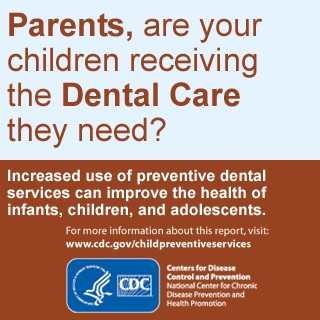Children's Oral Health

Overview
Cavities (also known as caries or tooth decay) are one of the most common chronic conditions of childhood in the United States. Untreated cavities can cause pain and infections that may lead to problems with eating, speaking, playing, and learning. Children who have poor oral health often miss more school and receive lower grades than children who don’t.
- About 1 of 5 (20%) children aged 5 to 11 years have at least one untreated decayed tooth.1
- 1 of 7 (13%) adolescents aged 12 to 19 years have at least one untreated decayed tooth.1
- Children aged 5 to 19 years from low-income families are twice as likely (25%) to have cavities, compared with children from higher-income households (11%).1
The good news is that cavities are preventable. Fluoride varnish can prevent about one-third (33%) of cavities in the primary (baby) teeth.2 Children living in communities with fluoridated tap water have fewer cavities than children whose water is not fluoridated.3 Similarly, children who brush daily with fluoride toothpaste will have fewer cavities.4
Dental sealants can also prevent cavities for many years. Applying dental sealants to the chewing surfaces of the back teeth prevent 80% of cavities.5

What Parents and Caregivers Can Do
Here are some things you can do to ensure good oral health for your child:
- Protect your child’s teeth with fluoride.
- Use fluoride toothpaste.
- For children younger than age 6, watch them brush their teeth. Make sure they use only a pea-sized amount of toothpaste and always spit it out rather than swallow it.
- For children younger than age 2, do not use fluoride toothpaste unless your doctor or dentist tells you to.
- Learn more about fluoride toothpaste and other sources of fluoride at Brush Up on Healthy Teeth.
- As soon as the first tooth appears in the mouth, talk to your pediatrician, family doctor, nurse, or dentist about fluoride varnish.
- If your drinking water is not fluoridated, ask your dentist, family doctor, or pediatrician if your child needs oral fluoride supplements. These are available in many forms, like drops, tablets, or lozenges.
- Use fluoride toothpaste.
- Talk to your child’s dentist about dental sealants.
- Have your child visit a dentist for a first checkup by age 1, as recommended by the American Academy of Pediatrics.
- Find a dentist if your child needs one. Use the Insure Kids Now Dentist Locator
Related Links for Health Professionals
- Community Preventive Service Task Force Recommendations for Improving Oral Health: Preventing Dental Caries (Cavities)
- Oral Health and Learning [PDF–81KB]
Related Links for Parents
- Infant Formula and Fluorosis
- Dental Sealants
- National Institute of Dental and Craniofacial Research’s A Healthy Mouth for Your Baby
- National Institute of Dental and Craniofacial Research’s Seal Out Tooth Decay
- American Academy of Pediatrics: Healthychildren.org
- American Academy of Pediatrics: Children’s Oral Health information
- American Academy of Pediatric Dentistry: My Children’s Teeth
- American Dental Association: Mouth Healthy
- Text4Baby: A free cellphone text messaging service for pregnant women and new moms that includes oral health messages.
References
1 Dye BA, Xianfen L, Beltrán-Aguilar ED. Selected Oral Health Indicators in the United States 2005–2008. NCHS Data Brief, no. 96. Hyattsville, MD: National Center for Health Statistics, Centers for Disease Control and Prevention; 2012.
2 Marinho VCC, Worthington HV, Walsh T, Clarkson JE. Fluoride varnishes for preventing dental caries in children and adolescents. Cochrane Database of Systematic Reviews. 2013; Issue 7. Art. No.: CD002279. DOI: 10.1002/14651858.CD002279.pub2.
3 Community Preventive Services Task Force. Preventing Dental Caries: Community Water Fluoridation website. http://www.thecommunityguide.org/oral/fluoridation.html. Accessed October 23, 2014.
4 Marinho VCC, Higgins JPT, Logan S, Sheiham A. Fluoride toothpastes for preventing dental caries in children and adolescents. Cochrane Database of Systematic Reviews. 2003; Issue 1. Art. No.: CD002278. DOI: 10.1002/14651858.CD002278.
5 Ahovuo-Saloranta A, Forss H, Walsh T, Hiiri A, Nordblad A, Mäkelä M, Worthington HV. Sealants for preventing dental decay in the permanent teeth. Cochrane Database of Systematic Reviews. 2013; Issue 3. Art. No.: CD001830. DOI: 10.1002/14651858.CD001830.pub4.
- Page last reviewed: May 4, 2016
- Page last updated: July 20, 2017
- Content source:


 ShareCompartir
ShareCompartir